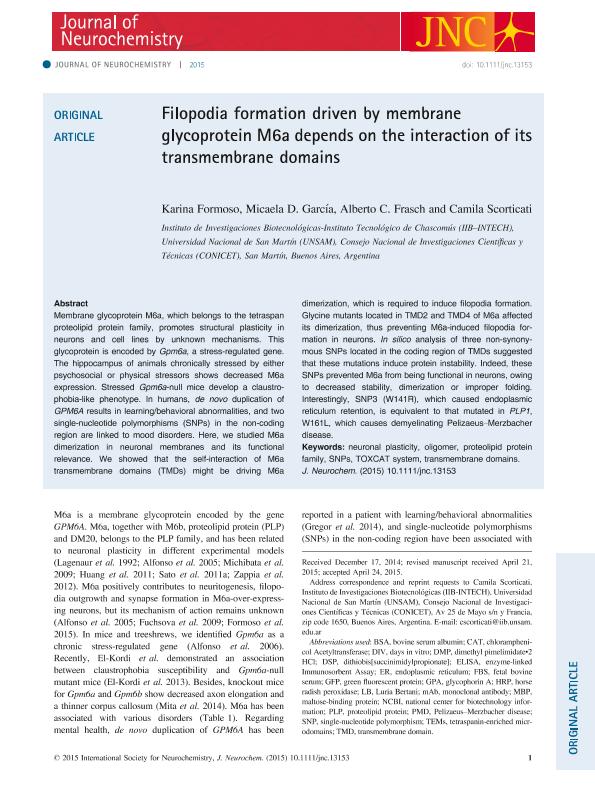Artículo
Filopodia formation driven by membrane glycoprotein M6a depends on the interaction of its transmembrane domains
Fecha de publicación:
08/2015
Editorial:
Wiley Blackwell Publishing, Inc
Revista:
Journal of Neurochemistry
ISSN:
0022-3042
Idioma:
Inglés
Tipo de recurso:
Artículo publicado
Clasificación temática:
Resumen
Membrane glycoprotein M6a, which belongs to the tetraspan proteolipid protein family, promotes structural plasticity in neurons and cell lines by unknown mechanisms. This glycoprotein is encoded by Gpm6a, a stress-regulated gene. The hippocampus of animals chronically stressed by either psychosocial or physical stressors shows decreased M6a expression. Stressed Gpm6a-null mice develop a claustrophobia-like phenotype. In humans, de novo duplication of GPM6A results in learning/behavioral abnormalities, and two single-nucleotide polymorphisms (SNPs) in the non-coding region are linked to mood disorders. Here, we studied M6a dimerization in neuronal membranes and its functional relevance. We showed that the self-interaction of M6a transmembrane domains (TMDs) might be driving M6a dimerization, which is required to induce filopodia formation. Glycine mutants located in TMD2 and TMD4 of M6a affected its dimerization, thus preventing M6a-induced filopodia formation in neurons. In silico analysis of three non-synonymous SNPs located in the coding region of TMDs suggested that these mutations induce protein instability. Indeed, these SNPs prevented M6a from being functional in neurons, owing to decreased stability, dimerization or improper folding. Interestingly, SNP3 (W141R), which caused endoplasmic reticulum retention, is equivalent to that mutated in PLP1, W161L, which causes demyelinating Pelizaeus-Merzbacher disease. In this work we analyzed the functional contribution of transmembrane domains (TMDs) of the neuronal membrane glycoprotein M6a. We determined that certain glycines present in TMD2 and TMD4 are critical for filopodia induction in neurons. In addition, three nsSNPs located in the coding region of TMD2 and TMD3 of GPM6A impair M6a function by affecting its stability, folding and dimer formation. In this work we analyzed the functional contribution of transmembrane domains (TMDs) of the neuronal membrane glycoprotein M6a. We determined that certain glycines present in TMD2 and TMD4 are critical for filopodia induction in neurons. In addition, three nsSNPs located in the coding region of TMD2 and TMD3 of GPM6A impair M6a function by affecting its stability, folding and dimer formation.
Archivos asociados
Licencia
Identificadores
Colecciones
Articulos(IIB-INTECH)
Articulos de INST.DE INVEST.BIOTECNOLOGICAS - INSTITUTO TECNOLOGICO CHASCOMUS
Articulos de INST.DE INVEST.BIOTECNOLOGICAS - INSTITUTO TECNOLOGICO CHASCOMUS
Citación
Formoso, Karina; Garcia, Micaela Daiana; Frasch, Alberto Carlos C.; Scorticati, Camila; Filopodia formation driven by membrane glycoprotein M6a depends on the interaction of its transmembrane domains; Wiley Blackwell Publishing, Inc; Journal of Neurochemistry; 134; 3; 8-2015; 499-512
Compartir
Altmétricas




